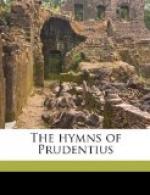damnatorum certis temporum intervallis existiment, si hoc eis placet,
aliquatenus mitigari, dummodo intelligatur in eis manere ira Dei, hoc
est ipsa damnatio. “Let men believe, if it so please them, that at
certain intervals the pains of the damned are somewhat alleviated,
provided that it be understood that the wrath of God, that is
damnation itself, abides upon them.”
140 It is somewhat startling to find Prudentius
speaking of the Holy
Eucharist in terms which
would recall to his contemporary readers
Virgilian phraseology
and the honeyed cake (liba) used in pagan
sacrifice. It must
be remembered, however, that in the early days of
the Church paganism
and Christianity flourished side by side for a
considerable period;
and we find various pagan practices allowed
to continue, where they
were innocent. Thus the bride-cake and the
bridal-veil are of heathen
origin; the mirth of the Saturnalia
survives, in a modified
form, in some of the rejoicings of Christmas;
and the flowers, which
had filled the pagan temples during the
Floralia, were employed
to adorn God’s House at the Easter festival.
141 The brilliant illumination of churches on
Easter Eve is very
ancient. According
to Eusebius, Constantine “turned the mystical
vigil into the light
of day by means of lamps suspended in every
part, setting up also
great waxen tapers, as large as columns,
throughout the city.”
Gregory of Nyssa also speaks of “the cloud
of fire mingling with
the rays of the rising sun, and making the eve
and the festival one
continuous day without interval of darkness.”
153 Cf. Paradise Lost, iii. 51:—
“So much the rather
thou, Celestial Light,
Shine inward, and the mind through all her
powers
Irradiate.”
VI
The last seven stanzas of this
hymn are used in the Moz. Brev. at
Compline on Passion Sunday, and daily until Maundy
Thursday.
56 Cf. Job. vii. 14: “Then Thou
scarest me with dreams, and terrifiest
me through visions.”
95 In the translation of this stanza the explanation
of Nebrissensis
is adopted, an early
editor of Prudentius (1512) and one of the
leaders of the Renaissance
in Spain. He considers that “the few of
the impious who are
condemned to eternal death” are the incurable
sinners, immedicabiles.
Others attempt to reconcile these words
with the general belief
of the early Church by maintaining that
non pii is not
equivalent to impii, but rather refers to the
class that is neither
decidedly good nor definitely bad, and that
the mercy of God is
extended to the majority of these. A third view
is that the poet is
speaking relatively, and means that few are
condemned in proportion
to the number that deserve condemnation.
In whatever way the
words are explained, it is interesting to find
an advocate of “the
larger hope” in the fourth century.




